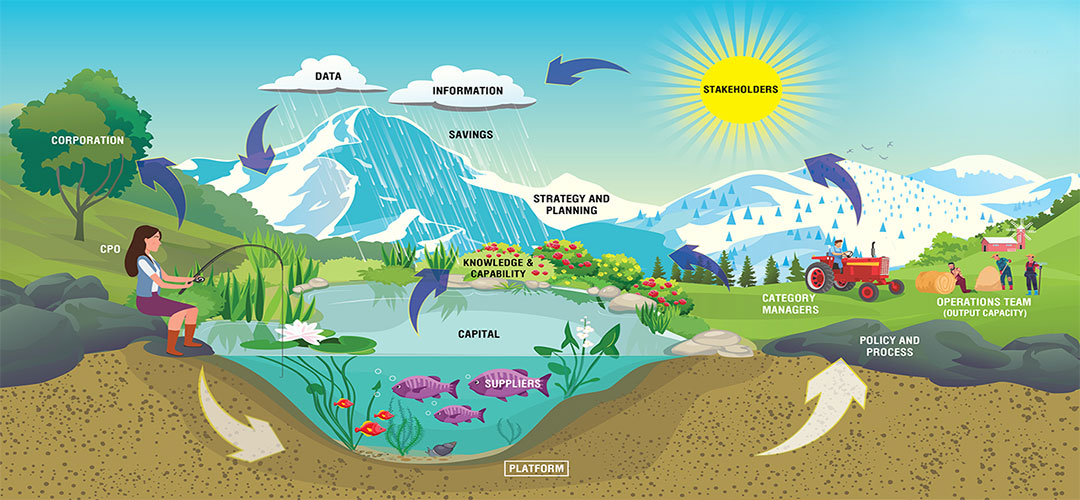Procurement As An Ecosystem: Becoming a Strategic Partner in the Digital Age
Imagine a strategic meeting is in progress inside your organization, focused on speeding up the market release of a product for competitive advantage. The chief procurement officer proposes an alternative to using a supplier-developed customized design and production process that will lock the company’s future product road map to a single supplier. His idea: use design-based bidding (DBB) so potential suppliers can propose a product design and manufacturing process that will build a custom design the company owns and that leverages generally available components.
The bids will be designed in collaboration with the company’s product engineering and management teams to help them achieve the required cost target, design objectives, and go-to-market acceleration.
Sounds futuristic? This is Next Generation Procurement, a partner focused singularly on value creation for the organization. Besides its pivotal role in achieving cost savings, Next Generation Procurement can act as the much-needed innovation catalyst connecting external expertise with internal business functions to maximize their potential in co-creation.
This allows an organization to orchestrate the identification, acquisition, and management of all external (third-party) resources in concert with its business imperatives to create sustainable value. This can be accomplished only by integrating with core functional stakeholder groups and aligning with their agendas.
Driving Sustainable Value
As in any core function, establishing a robust, well-functioning operating model is at the heart of the procurement as an ecosystem. Our research shows that 80% of high-performing procurement organizations distinguish strategic from operational roles. Imagine a model in which operational execution tasks are removed from strategic planning; category managers are closely aligned with business stakeholders; a center of excellence provides category managers with the knowledge, data, tools, templates, methodology, and coaching they need; and a service desk responds to the organization, streamlining and prioritizing routine tasks in a timely manner.
A robust ecosystem provides connectivity and information flow among the key players without friction. Next-generation procurement calls for agile decision making. Suppliers are identified based on relevant, timely market intelligence. They are selected based on the best available information, obtained during the strategic sourcing process. Suppliers are managed based on actual performance metrics and changing risk and market dynamics.
The starting point for a healthy procurement ecosystem lies in creating a world-class data, information, and intelligence strategy that provides visibility into spending decisions, consumption patterns, performance and quality data, supply chain risks, market insights, and intelligence.
Information and insights help category management teams develop smart strategies, identify a portfolio of value-creation projects, and mature their categories over time. Such an approach creates sustainable value. Saving becomes a natural outcome, but not the objective—building sustainable procurement models is the primary goal.
The Power of Embedding Technology
Next Generation Procurement has to embed digital enablers to achieve its mandate. Robotic process automation (RPA), artificial intelligence (AI), advanced analytics, and peer-to-peer platforms are generic terms used loosely by procurement practitioners. Combining AI, RPA, and analytics to provide a superior buying experience to corporate users is a must in Next Generation Procurement. It includes weaving market insights with spend/supplier data to offer predictive analytics to category managers; applying knowledge management and AI technologies to capture, organize, and reuse knowledge gained from each project; and automating routine tasks so no human touches a purchase request (PR) before it converts to a purchase order (PO).
Refocusing on Talent
A strategic approach also calls for attracting and retaining the right talent. Our research found that almost 90% of high-performing procurement teams consider business acumen, relationship building, and category knowledge to be crucial. In the new model, technology and analytical skills will also be important capabilities. Organizations will need to invest in new-age skilling approaches—such as micro-learning and peer-to-peer learning—with emphasis on knowledge management.
Architecture of a Procurement as an Ecosystem
Creating an ecosystem of talent, digital enablers, information, processes, and knowledge artifacts is the keystone of Next Generation Procurement. Dedicated teams for things such as strategic support, source-to-manage execution, and transaction execution enable laser-sharp focus on crucial tasks. Insulated from tactical activities, category managers can focus on strategic initiatives. The strategic support team aids them with market research, category plan development, and stakeholder workshops. The source-to-manage execution team manages projects, RFXs, contract authoring, and execution. The transaction execution team minimizes the effort to review and respond to traditional procurement back-office operations.
There is no one-size-fits-all solution, as every organization has a unique business context, legacy, and maturity level. Along with the right team, leaders must be fully invested in and committed to providing the support required for the long term.
Another key aspect often overlooked is that any model will evolve. Expecting immediate results or failing to continually adapt the model to changing business needs can be counterproductive for success.
Total business alignment is the value that next-generation procurement brings to the table. Our research reveals that 60% of high performers in procurement have a clearly documented vision and value proposition. Procurement must be inducted into an organization’s inner circle—and must be an integral part of a company’s goal-setting process from the beginning.



